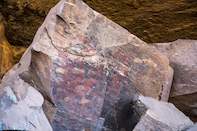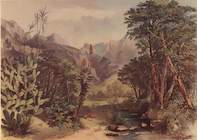Rock Art
The history of South African art starts with the history of man and their aim to visually depict their life and way of living. In SA, art was once a simple finger-painting of a buck being speared down by a group of stick men on the wall of a cave in animal’s blood.

It is now much more complicated, but it has always taken on the unique flavour of the country. Rock art was the name given to the paintings of the San-bushmen people, who were the first residents of the land. They mixed animal blood with sand, rock and clay and painted their life on the walls of caves they resided in. Most of these paintings were centred around people and the animals they hunted, or weapons they made and tools they used. The subjects were simple yet varied, and stayed in a colour palette of red, brown and black.
Over the next 4000 years, a vast body of art on the walls of caves and rock shelters were created throughout SA. The most famous and concentrated depictions are located in the massive Drakensberg range of mountains in KwaZulu-Natal. UNESCO described the area as “outstanding both in quality and diversity of subject”.
The ‘New’ World

The first Europeans to settle in South Africa were the Dutch, who came to set up a refreshment station in the Cape in the mid-1600s. During the next century, settlers from various other European countries flocked to the country to farm the fertile land. Eventually, the British colonised SA in the 1800s, and a ‘new’ world order was established.
During this period, art and architecture was heavily influenced by the Victorian and Edwardian eras, and some smaller towns are still home to traditional houses built in such styles. Artists such as Thomas Baines depicted the country as a wildlife paradise of sorts - intricate and detailed paintings of wildlife, rocky outcrops and lush greenery made its way back to Europe as a form of reporting.
The ‘untamed wilderness’ of South Africa was splashed onto canvases in muted watercolours, and the focus was placed on the landscape rather than inhabitants. If you were of a bold stance, you’d paint the fascinating trials and tribulations of the Xhosa and Zulu tribes, like George Angas.
During the later years leading up to the 20th century, the British nation, Boer settlers and native tribes were at odds with one another. This resulted in the formation of Afrikaner nationalist ideology, which in turn influenced the art scene, which was then still heavily based on an “outsider” view of the country. The geometric landscapes of Dutch-born painter JH Pierneef were soon setting the trend for early 1900s art, and the move towards industrialization allowed artists to experiment with metal as a medium for sculpture.
Political Art
At the start of the 1900s, South Africa was an emerging ‘gem’ - the diamond and gold mining industry was booming, and the urbanization of workers influenced the direction in which the country’s art was moving. Post-impressionism and expressionism was combined with the plight of exploited workers to create a bold movement focused on individuals within their environment rather than just one specific subject of beauty.
African forms and traditional craftsmanship took centre stage in the world of colonial art during the 1940s, which helped the country’s art scene to move towards a simple touch of modernism infused with a burst of much-needed visual energy.
Although art was always a social and political comment on the clime of the country, it became quite important during the apartheid years, which started in the 1950s. Segregation and repressive laws chained black artists to the ground in an effort to suppress their opinions and liberation efforts.
The lives of people of colour became the subject of an underground art movement; human subjects were often placed in the background of their mundane environment. Artists Gerard Sekoto and George Pemba depicted life in Sophiatown and District Six without apology and with bold colour combinations. They showed the humanity of people who were the most vulnerable and susceptible to oppression. Protest art was a popular form of expression during the 1980s, often seen on murals and graffiti.
During the 1990s, when the liberation movement was at its height, artists expressed their frustration and anger through art with colour, dark imagery and harsh lines. Ultimately, their art showed the deep slash apratheid made in the heart of the country; a festering wound that will never heal. The 21st century was ushered in with a postmodern art scene with controversial topics that explored the previous centuries’ scars.
The Next Generation
The early 2000s in South Africa represented immense change in the country - local artists were exposed to worldwide art phenomenons and movements that were blocked during the apartheid years, and thus the country’s art scene rapidly expanded. Pop art, scandinavian art and new world technology dominated certain scenes and conversations in art, while others went back to their roots and embraced traditional arts and crafts, which was quite a dichotomy with the rest of the world.
Local artists had more options and muses to base their art on. Sculptures, pottery, beadwork, ceramics and 3D art was at the forefront of the new century, and was inspired by both African geometry and postmodernism. Photography and audiovisual pieces were incorporated into national galleries and museums that tackled controversial topics and social issues, and there were various phases where the Renaissance and Baroque periods influenced new art.
With an influx of tourism, South African artists chose to celebrate local 'vibes' with bursts of colour and visual drama that transcended the canvas; it could be seen in 3D art, photography and video projects. Today, South African art is loud and graphic, with intimate undertones of controversial topics and whimsical shapes.
 It was only in the second half of the nineteenth century that public collections of African art began to be amassed in response to the emerg...
It was only in the second half of the nineteenth century that public collections of African art began to be amassed in response to the emerg... The written records of the San folklore, their beliefs and life stories were compiled by German philologist Dr Wilhelm Bleek and his sister-...
The written records of the San folklore, their beliefs and life stories were compiled by German philologist Dr Wilhelm Bleek and his sister-...